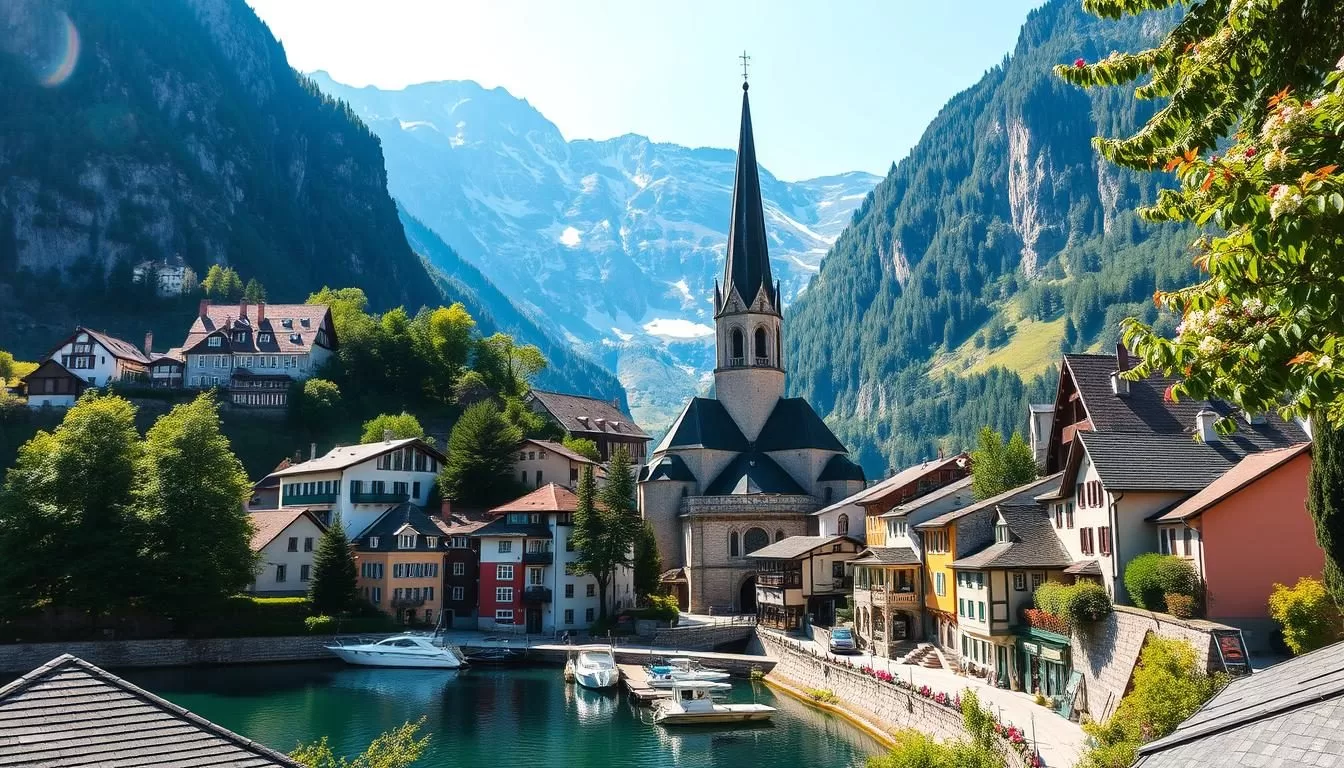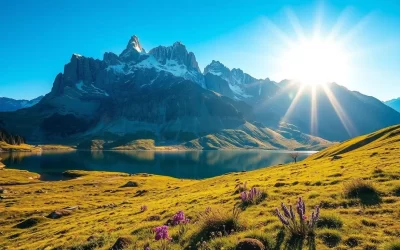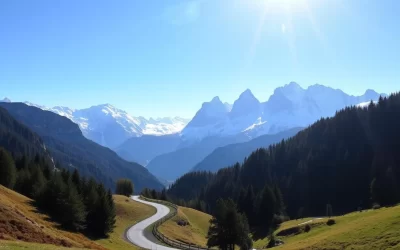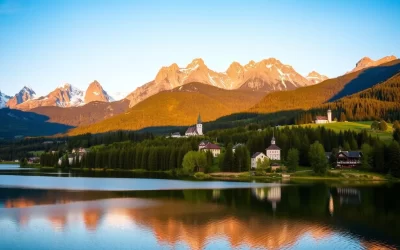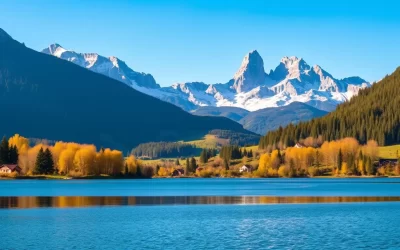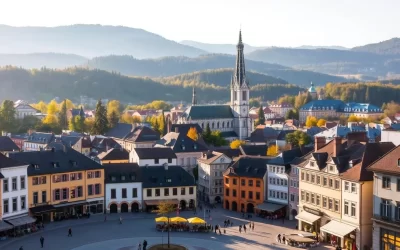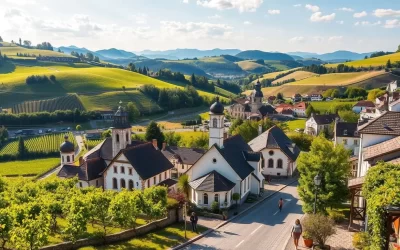Nestled between towering mountains and the serene Hallstätter See, this picturesque town has evolved from a quiet alpine village to one of Austria’s most visited destinations. You can explore this charming town from end to end in just fifteen minutes, taking in its historical and natural attractions.
Despite its small size, Hallstatt offers a rich experience with its myriad of attractions. You can easily spend a day discovering its heritage sites and enjoying the breathtaking scenery. Whether you’re planning a trip from nearby cities like Salzburg or Vienna, or just stopping by for the things to see, Hallstatt promises an unforgettable visit.
Discovering the Fairytale Village of Hallstatt
With a history spanning nearly 7,000 years, Hallstatt is a place where the past and present blend seamlessly. As you explore this enchanting village, you’ll uncover layers of history, culture, and natural beauty that make Hallstatt a truly unique destination.
A Brief History of Hallstatt
Hallstatt’s story began during the Neolithic Age, making it the oldest salt mine in the world. The village has been a hub of salt mining activity for millennia, with the “white gold” bringing wealth and prosperity to the town. The significance of Hallstatt’s salt mining history is evident in its recognition as a UNESCO World Heritage Site in 1997, primarily due to the Hallstatt Culture that thrived during the Bronze and Iron Ages.
| Period | Significance | Impact on Hallstatt |
|---|---|---|
| Neolithic Age | Beginning of salt mining | Established Hallstatt as a major salt production center |
| Bronze and Iron Ages | Hallstatt Culture thrived | Contributed to Hallstatt’s cultural and historical significance |
| 1997 | UNESCO World Heritage Site designation | Recognized Hallstatt’s cultural and historical importance globally |
Why Hallstatt Has Become So Popular
The release of Disney’s Frozen in 2013 marked a significant turning point in Hallstatt’s popularity, with the village being rumored as the inspiration for Arendelle. This exposure, coupled with the rise of social media, has transformed Hallstatt into one of Europe’s most photographed destinations. As a result, the town now faces the challenges associated with overtourism, making it a fascinating case study in the impact of global recognition on small place where people live.
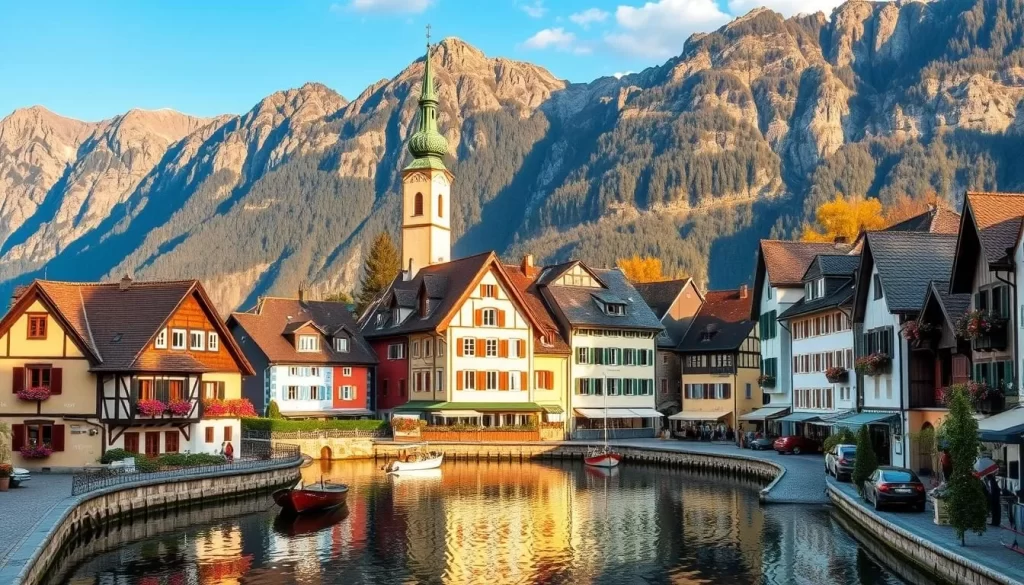
Best Time to Visit Hallstatt
To make the most of your trip to Hallstatt, understanding the village’s seasonal dynamics is essential. The peak tourist season in Hallstatt runs during the summer months of June, July, and August, with crowds sometimes extending into September.
Peak Season vs. Off-Season
During the peak season, you can expect large crowds and higher prices. If you’re looking for a more serene experience, consider visiting during the spring (March-May) or fall (October-November), when the weather is pleasant and the crowds are smaller.
Weather Considerations
The weather in Hallstatt can be unpredictable, especially in the alpine region. It’s advisable to pack layers regardless of when you visit. Here’s a breakdown of what to expect during different months:
| Season | Months | Weather | Crowd Level |
|---|---|---|---|
| Peak Season | June, July, August | Warm | High |
| Spring | March, April, May | Mild | Low |
| Winter | December, January, February | Cold, Snow | Medium |
| Autumn | October, November | Cool | Low |
If you visit during the peak summer months, arriving early (before 9 am) or staying late (after 4 pm) provides a more peaceful experience when day-trippers have departed. This way, you can enjoy Hallstatt with fewer people around, making your visit more enjoyable and allowing you to appreciate the village’s charm at your own time.
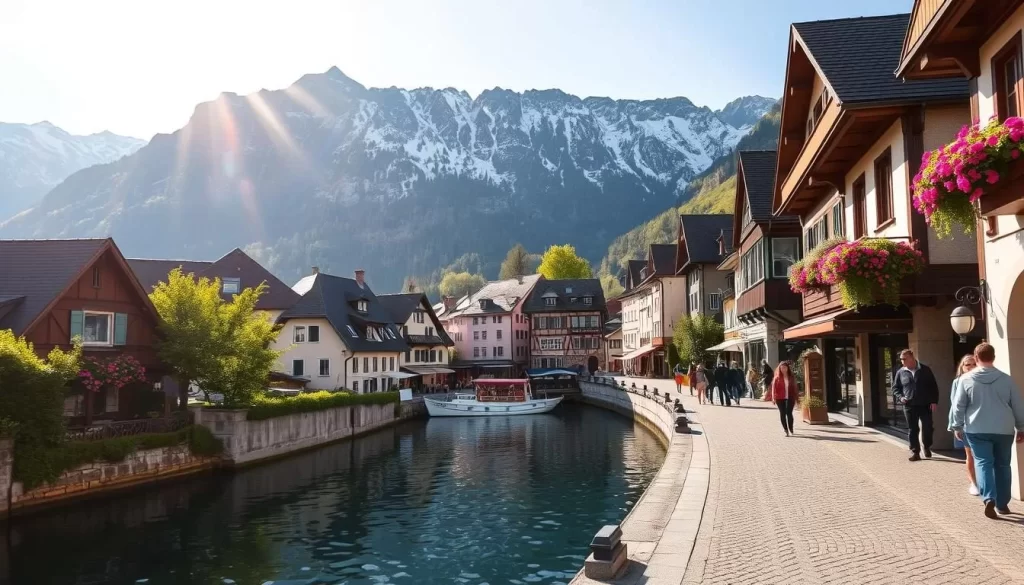
How to Get to Hallstatt
Getting to Hallstatt is easier than you think, with convenient train, bus, and car options.
Hallstatt is accessible by train from major Austrian cities like Salzburg and Vienna. The journey involves a change of trains at Attnang-Puchheim station.
From Salzburg
The train journey from Salzburg to Hallstatt takes a little over two hours. You’ll need to change trains at Attnang-Puchheim, but the connection is typically smooth.
Upon arrival at the Hallstatt train station, you’ll need to take a ferry to reach the village center, which takes about 10 minutes.
From Vienna
Traveling by train from Vienna takes around 3.5 hours, with a change at Attnang-Puchheim station. The scenic route is comfortable and relatively quick.
Alternatively, you can drive to Hallstatt. The trip takes about an hour from Salzburg and three hours from Vienna. Parking is available at the P1 or P2 lots.
Transportation Tips
If you prefer to travel by bus, routes 150, 542, or 543 are available, taking around 2 hours and 15 minutes from Salzburg. Be aware that parking can be challenging during peak season, so plan accordingly.
Whether you choose to travel by train, car, or bus, getting to Hallstatt is relatively straightforward. Just be sure to check the latest schedules and plan your trip in advance.
Hallstatt, Austria: Best Things to Do – Top Picks
Hallstatt, a picturesque village nestled between the mountains and Hallstätter See, is a treasure trove of experiences waiting to be discovered. As you explore this charming town, you’ll be captivated by its unique blend of natural beauty and cultural heritage.
Explore the Historic Town Center
Wandering through Hallstatt’s historic town center is like stepping into a fairytale. The streets are lined with colorful houses that resemble gingerbread, and the scenery is nothing short of breathtaking. Take your time to soak in the atmosphere and capture the perfect shot.
Visit the Iconic Viewpoints
For an unforgettable view of Hallstatt, head to the north-side viewpoint, known as Aussichtspunkt Hallstatt on Google Maps. This spot offers the iconic postcard view of the town with its spire reflected in the lake. Alternatively, visit the lesser-known south-side viewpoint for a different perspective on this picturesque village.
Take a Ferry Ride on Hallstätter See
A ferry ride on Hallstätter lake provides a unique perspective on Hallstatt, especially during the early morning when the water is calm and the crowds are minimal. You’ll have the opportunity to appreciate the things that make Hallstatt so special from a different angle.
To make the most of your visit, consider arriving early or booking a photography tour to capture Hallstatt’s beauty without the midday crowds. With its array of things to see and do, Hallstatt is sure to leave a lasting impression on you.
Tour the Ancient Hallstatt Salt Mine
One of the most fascinating experiences you can have in Hallstatt is touring the ancient salt mine. For thousands of years, salt has been mined from the mountains around Hallstatt, earning it the nickname “white gold” due to its value and the wealth it brought to the region.
History of the “White Gold”
Hallstatt is home to the world’s oldest salt mine, with a history dating back an impressive 7,000 years. The salt mine has been a cornerstone of the local economy and culture, shaping the community’s identity over millennia. The mine’s significance is not just historical; it’s a living testament to the ingenuity and perseverance of the people who mined it.
What to Expect on the Salt Mine Tour
The 90-minute guided tour takes you deep into the mountain, where you’ll explore ancient mining tunnels and learn about prehistoric mining techniques. The tour is an immersive experience, featuring interactive elements such as thrilling 64-meter miners’ slides, light and sound shows, and 3D video projections. You’ll also have the opportunity to see the world’s oldest wooden staircase, dating back 3,100 years, a remarkable archaeological find.
To make the most of your visit, budget approximately 3 hours for the complete experience, including the round-trip ride on the funicular. It’s advisable to book early time slots as tours operate on a first-come, first-served basis, ensuring that you have a smooth and enjoyable experience.
Visit the Hallstatt Skywalk
Perched 350 meters above the charming town of Hallstatt, the Hallstatt Skywalk offers breathtaking views that are sure to leave you spellbound. This viewing platform is a must-visit attraction for anyone traveling to Hallstatt, providing a unique perspective on the town and its surroundings.
Getting to the Skywalk
To reach the Hallstatt Skywalk, you have two options: take the funicular (also known as a cable car) from the valley station, or hike up for approximately one hour. The funicular ride costs around €24 for a round trip. For those who prefer a more leisurely experience, the funicular is a convenient option, departing regularly from the cable car station near the town center.
Panoramic Views from Above
From the Skywalk, you’ll be treated to spectacular 360-degree views of the Dachstein Salzkammergut region. You’ll see the town of Hallstatt nestled between the mountains and the lake, offering a truly unforgettable panorama. On a clear day, the views are simply stunning, making it a perfect spot for photography.
Practical Information
After taking in the views, you can relax at the on-site café or restaurant, where you can enjoy refreshments while still taking in the scenery. For the best value, consider purchasing a combination ticket that includes a roundtrip funicular ride, the salt mine tour, and access to the Skywalk viewpoint, all for approximately €36 per person. This ticket is a great way to make the most of your visit to Hallstatt.
Explore the Bone House (Beinhaus)
One of Hallstatt’s most fascinating and macabre attractions is the Bone House, a small chapel filled with intricately arranged human skulls and bones. Located behind the Catholic Church, this unique site is a must-visit when in Hallstatt.
The Fascinating History of Hallstatt’s Ossuary
The Bone House, also known as Beinhaus or Charnel House, exists due to the limited burial space in the small town of Hallstatt. Historically, bodies were exhumed after 10-15 years to make room for the newly deceased. The exhumed bones were then cleaned and stacked in the Bone House, with skulls being painted with various motifs.
This practice was a way of remembering the deceased and was continued until the 1960s when the Catholic Church allowed cremation. The Bone House now serves as a historical record of local customs and contains over 2,100 skulls and bones.
Visiting the Painted Skulls
Upon visiting the Bone House, you will be struck by the intricate paintings on the skulls, which include roses, wreaths, and crosses. The style of painting indicates the time period, with darker garlands signifying 18th-century skulls and brighter floral patterns denoting more recent ones. The two skulls with snakes symbolize death and sin.
The Bone House is open daily from 11:30 AM to 3:30 PM, with a modest entrance fee of €1.50, making it an affordable and intriguing stop on your Hallstatt itinerary. As you explore this unique place, you will gain insight into the town‘s history and the people who lived there.
Visit Hallstatt’s Churches and Town Square
Your visit to Hallstatt wouldn’t be complete without exploring its iconic churches and bustling Market Square. The town is home to several significant religious landmarks that not only reflect its rich history but also offer a glimpse into the local culture.
The Catholic Church of Maria am Berg
Perched on the mountainside, the Catholic Church of Maria am Berg is a stunning example of 18th-century Baroque architecture. This church boasts a grand exterior with a sweeping staircase and a large dome, offering breathtaking views of Hallstatt and the surrounding lake. Inside, you’ll find beautiful frescoes, ornate altars, and stunning stained glass windows that reflect the region’s deep religious heritage.
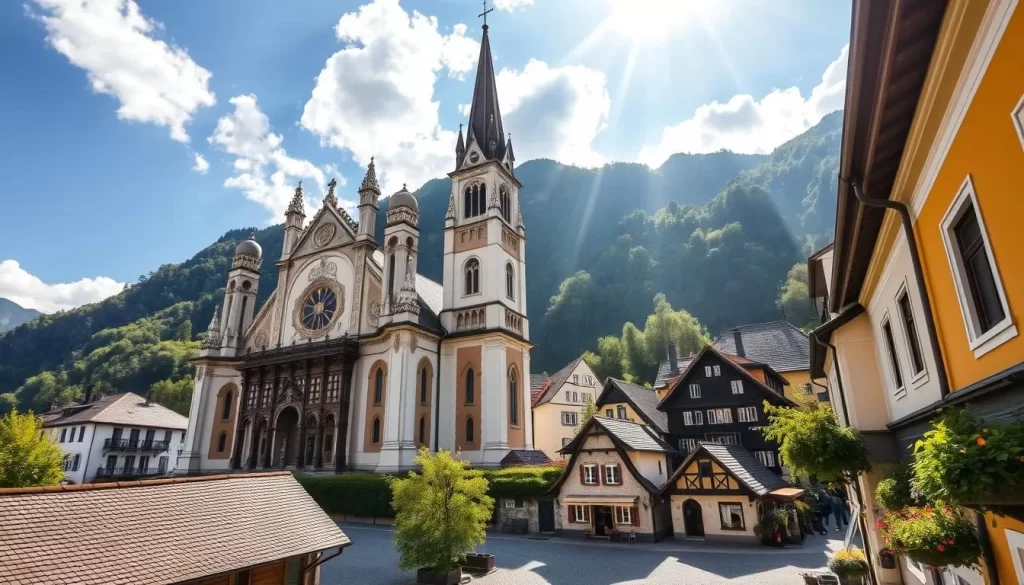
The Protestant Church
The Protestant Church, or Hallstatt Lutheran Church, is another significant landmark in the town. Built in the 18th century, it features a striking Baroque-style exterior and serves as both a religious center and a community gathering place for locals. The church’s interior is adorned with beautiful frescoes and altars, adding to the town’s cultural richness.
Market Square (Marktplatz)
At the heart of Hallstatt lies the charming Market Square, or Marktplatz, a cobblestone square that is the epicenter of local life. Marked by the statue of the Holy Trinity, the square is surrounded by colorful traditional alpine houses with wooden balconies adorned with flowers. During the summer, the square hosts an open-air market where local artisans and farmers sell handmade crafts and fresh produce, making it a vibrant and bustling square that embodies the spirit of Hallstatt.
Day Trip to Dachstein Krippenstein
If you’re looking for an adventure beyond Hallstatt, consider a day trip to Dachstein Krippenstein. Located just a few minutes away from Hallstatt, this destination offers a unique blend of alpine scenery, hiking opportunities, and spectacular views across the Alps.
The Giant Ice Cave
One of the main attractions at Dachstein Krippenstein is the ice cave, a natural wonder located in the Dachstein mountain range. The cave is known for its stunning ice formations, including stalactites and stalagmites, which you can explore on a guided 50-minute tour. Be sure to dress warmly, as temperatures inside the cave can drop to -5°C even in summer.
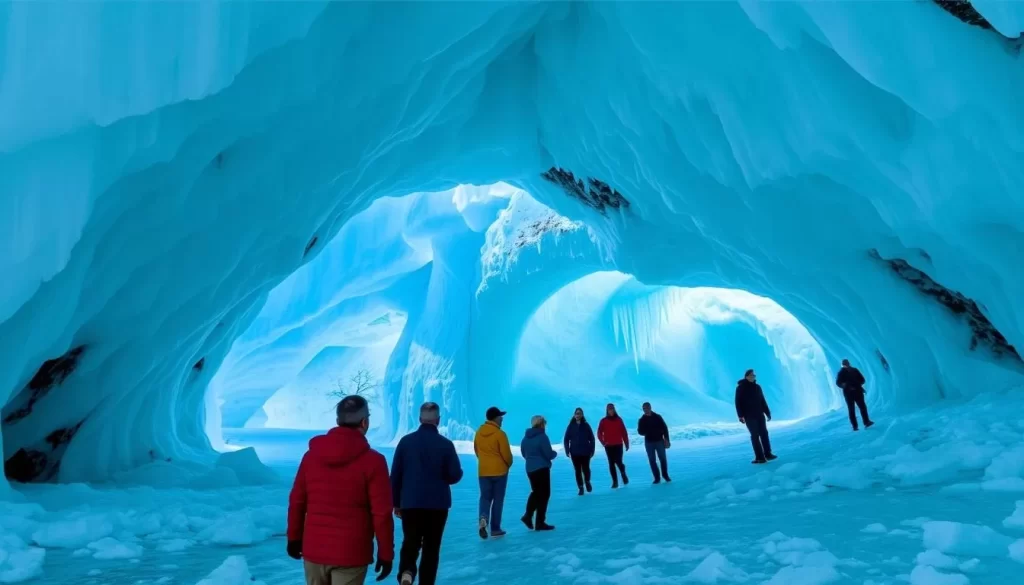
5 Fingers Viewing Platform
Another highlight of visiting Dachstein Krippenstein is the 5 Fingers viewing platform, a unique, hand-shaped observation deck with five viewing platforms extending 400 meters above the ground. From here, you can enjoy panoramic views of the Alps, making it a truly unforgettable experience.
5 Fingers viewing platform image
Hiking Opportunities
Dachstein Krippenstein also offers numerous hiking trails for all skill levels, from easy family-friendly paths to more challenging routes for experienced hikers. Whether you’re looking for a leisurely stroll or an adrenaline-packed adventure, there’s something for everyone.
To get to Dachstein Krippenstein, take bus routes 542 or 543 from Hallstatt to the Obertraun cable car station. From there, a cable car ride will take you to the top, where you can explore the ice cave, 5 Fingers viewing platform, and enjoy hiking in the beautiful alpine scenery.
Get Out on the Water
Sail into the heart of Hallstatt’s charm with a boat trip on Hallstätter See. Renting a boat allows you to explore the picturesque town and surrounding mountains from a unique perspective, offering some of the most spectacular views.
Boat Rental Options
During the warmer months, you can rent various types of boats, including swan paddleboats, small motorboats, rowboats, and stand-up paddleboards. This variety caters to different preferences and ages, ensuring everyone can enjoy the serene waters of Hallstätter See.
The rental options are available from April through October, with prices ranging from €15-30 per hour, depending on the type of watercraft. Choosing the right boat depends on your desired experience: whether you prefer a leisurely paddle or an electric boat for a more relaxed tour.
Best Views of Hallstatt from the Lake
Some of the most memorable views of Hallstatt are from the water. By renting your own boat, you can take your time admiring the town’s picturesque shoreline without the constraints of a guided tour. Early morning or evening rentals are particularly recommended for their calm waters and magical lighting, ideal for photography.
As you glide across Hallstätter See, you’ll appreciate Hallstatt’s scale and beauty from a new angle. The surrounding mountains and the town’s historic architecture create a breathtaking panorama that is sure to leave a lasting impression.
Where to Stay and Eat in Hallstatt
When planning your trip to Hallstatt, finding the right place to stay and eat can greatly enhance your experience. Hallstatt is a small town, but it offers a variety of accommodations and dining options that can make your stay memorable.
Accommodation Options
Hallstatt offers a range of accommodations from cozy guesthouses to boutique hotels. Staying overnight in Hallstatt allows you to experience the town’s tranquil atmosphere after the day-trippers leave.
Some top-rated properties within Hallstatt include I da Mitt and Haus Salzberg. I da Mitt offers spacious double rooms in the city center, while Haus Salzberg provides apartments that can accommodate 3 to 6 people, with the added perk of parking.
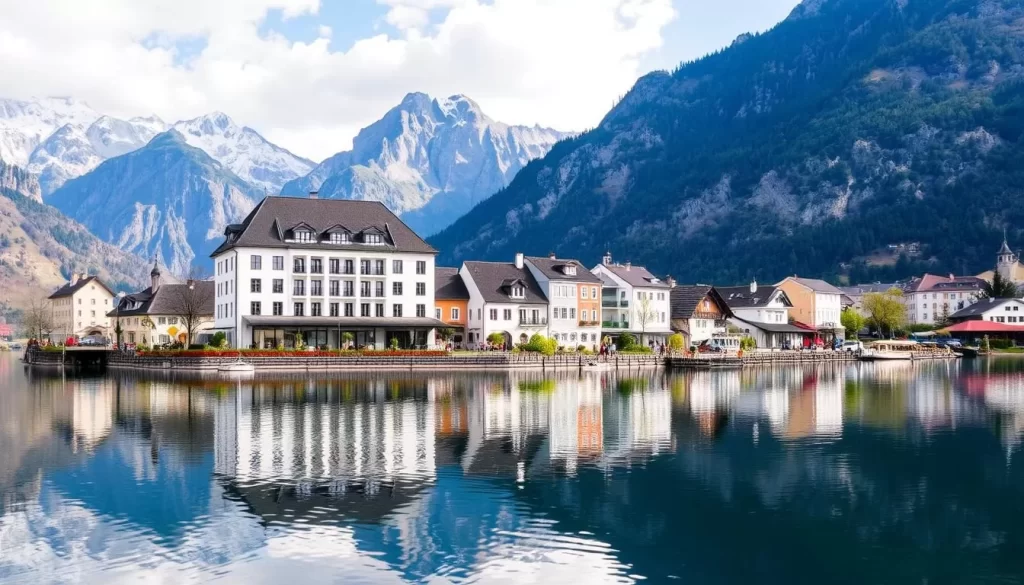
For those looking for alternatives, Obertraun, just 3 miles away, offers properties like Haus Salzkammergut and Haus Hepi B&B. These options provide more space and better value, with easy access to Hallstatt via public transportation.
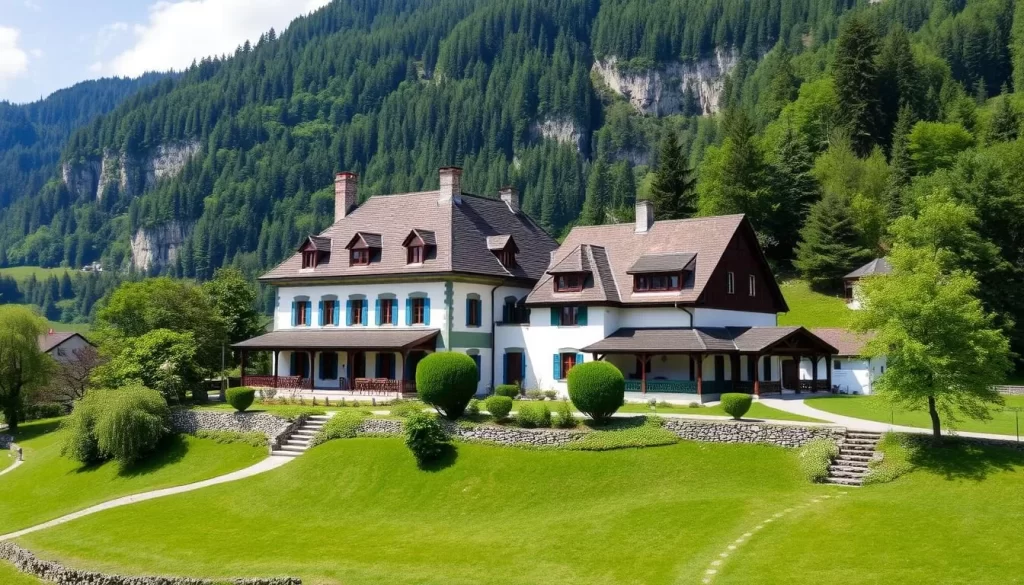
Another nearby option is Bad Goisern, with properties like Hotel Moserwirt. This hotel offers a quieter base for exploring the region, with family rooms that include a living area and a balcony overlooking the town.
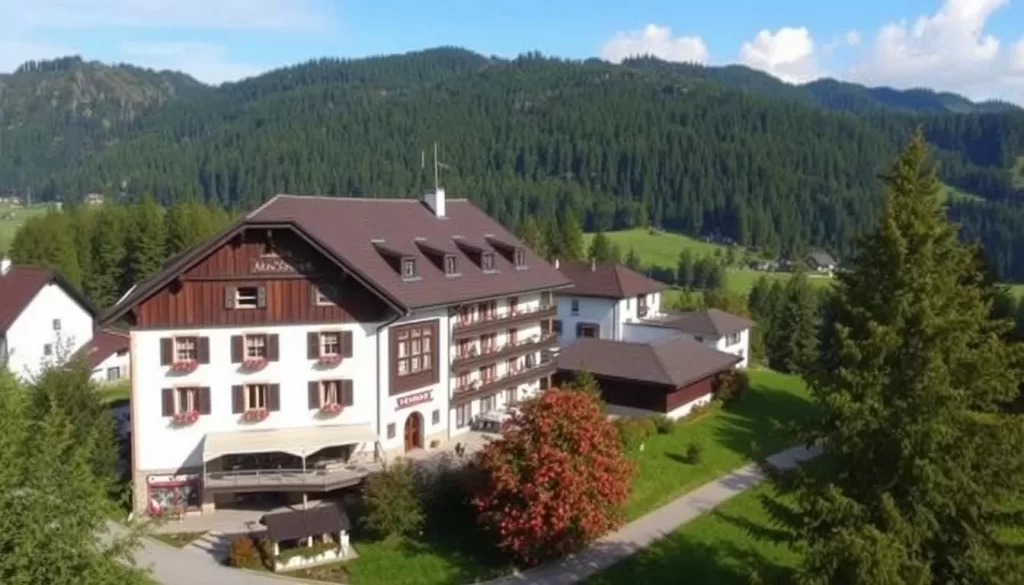
Restaurants and Cafés
Hallstatt is not just about its scenic views; it also offers a range of dining options that showcase local Austrian cuisine. From traditional restaurants to charming cafés, you can enjoy a variety of dishes while taking in the views of Hallstätter See.
Some of the best dining experiences include trying traditional Austrian specialties and enjoying coffee and pastries at one of the local cafés. Be sure to explore the town’s main square and surrounding areas to discover these hidden gems.
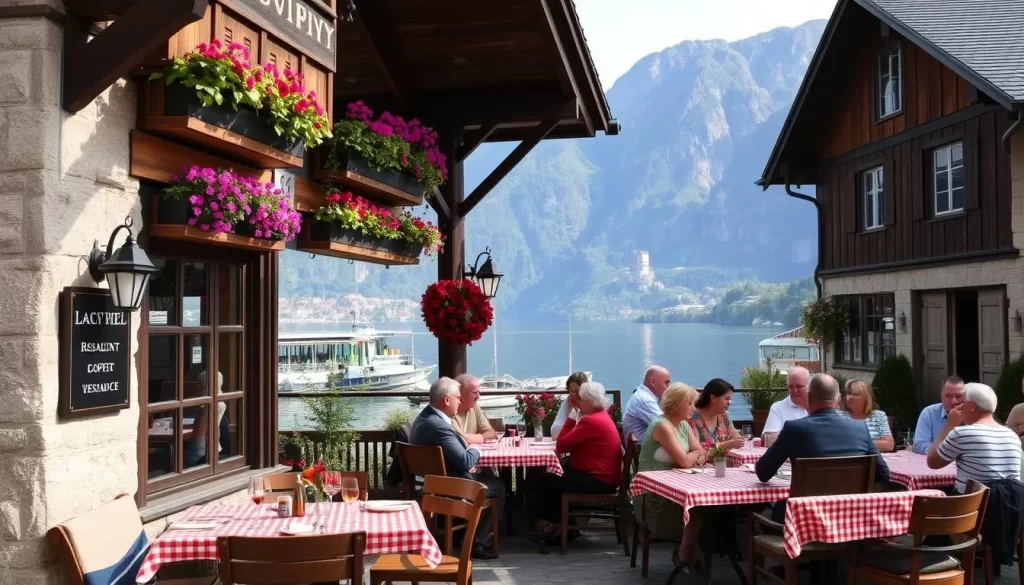
To make the most of your time in Hallstatt, consider staying in the town or nearby areas like Obertraun or Bad Goisern. This will give you a chance to fully experience the charm of the town and its surroundings.
Conclusion: Is Hallstatt Worth Visiting?
With its unique blend of natural beauty and historical significance, Hallstatt is a must-visit destination in Austria. You can have a wonderful experience in Hallstatt with proper planning and realistic expectations about crowds, especially during peak season.
To truly enjoy Hallstatt, consider staying at least one night in or near the charming town. This allows you to experience Hallstatt’s authentic atmosphere in the early morning and evening hours when day-trippers are absent, making your trip more enjoyable.
A balanced itinerary that includes Hallstatt’s highlights and nearby attractions like Dachstein will maximize your time in the region. By visiting during the off-season or exploring early/late in the day, you can avoid crowds and enjoy a more relaxed experience.
In conclusion, despite its popularity, Hallstatt remains one of Austria’s most magical destinations, offering a unique blend of natural beauty, rich history, and alpine charm. So, is Hallstatt worth visiting? Absolutely, and with the right planning, your day trip or longer stay will be an unforgettable experience.
The above is subject to change.
Check back often to TRAVEL.COM for the latest travel tips and deals.
